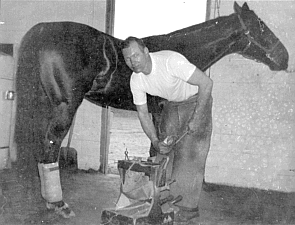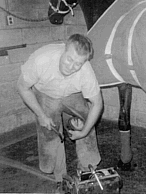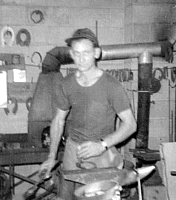
at Liberty Bell Park in Philadelphia.
photo by Charlie Guimarra
a story from "Sunday on the Farm - Memoirs of a Horseshoer"
© Bruce B. Daniels
published in ANVIL Magazine, August 1997
Bruce Daniels shares over 45 years of stories about shoeing horses. "Sunday on the Farm - Memoirs of a Horseshoer" includes 25 personal accounts. Some are humorous. Some are sad. All are true. Bruce can be contacted at P.O. Box 246, Harrisonville, New Jersey 08039 USA. Phone/Fax 609/478-2535
 |
| The Author shoeing Albatross in the late 1960s at Liberty Bell Park in Philadelphia. photo by Charlie Guimarra |
Thereís an appearance of competition for work between horseshoers on a Standardbred racetrack, but itís deceiving. After all, when there are a thousand horses stabled on the grounds and only eight or nine horseshoers, there is plenty of work for everyone. Almost everyone has a few customers theyíve worked for since they started. This could be a curse or a blessing. Perhaps they share a mutual trust or the horseshoer may be the only one they can get at their winter training farm or they are the only one who would work for the money they were offered. For whatever reason, most of the trainers go to the same horseshoer year after year.
Then there are always some trainers who, as soon as they shipped in, went down to the shop looking for the horseshoer who did their shoeing the year before. The bottom line is that if you shoe at the same racetrack year after year, youíll most likely end up shoeing for the same stables. If you do good work, itís not hard to pick up more horses than you can handle and find yourself overloaded. So there really isnít any need to cut prices or try to steal anyone elseís business. With a few exceptions, everyone got along just fine. Unless they are looking for an early grave, most Standardbred horseshoers try to shoe no more than eight horses a day. If you do that five days a week, and the horses are shod every three weeks, you canít handle more than a hundred and twenty horses and keep up. Realistically, most horseshoers are looking forward to the day when some of the horses canít qualify, or go lame, and they are down to an even hundred. Thatís a comfortable number to keep shod, and you might even get to go home early once in a while. Speaking from experience, as you get older, eight horses is one or two more than you want to get under day after day. As I said, competition wasnít a big problem when I was at the track. Most of the horseshoers would visit each otherís shop when they had a chance, and occasionally we would go to lunch together.
There was a time we had a little ritual about lunch. Jack Adams shared a shop with Edgar Landry on my side of the track, and when the two of them were finished with their morning work, they would drive over in Jackís truck, pick me up, and we would go to a local diner for a decent lunch.
Jackís father, Jake, had shod race horses for Levi Harmer in Bloomsburg, Pennsylvania for years, and Jack took over where Jake left off. There was no half way with Jack. His dad taught him what there was to know about shoeing horses, and he didnít want to hear about any new and improved ideas.
He was built like the pictures we see of Abe Lincoln splitting rails — tall and strong, but without an ounce of fat. When I went to Delaware, and became the Ďnew kid on the block,í Jack was my neighbor. He threw some work my way, and I appreciated it. He was raised hard by Jake, and he called a spade a spade. Well actually, he called it a friggen shovel. An honest man who spoke his mind, he evidently wasnít an easy guy for everyone to get along with, but I did, and respected him for it.
 |
| Edgar "Pat" Landry - he shod as many horses as anyone else, but he did it with a wooden leg. photo by Beans McWhinney |
Edgar came down from Canada a few years later. He was French-Canadian and although it was obvious that French was his first language, his English wasnít all that bad. Sometimes itís easy to tell where someone comes from just by looking at them, and with Edgar one look at him and you knew he was French. I couldnít put my finger on it, but for me, some national characteristics seem to stand out. No one had to tell me where Edgar came from. He was a hard worker, and with so many Canadian stables racing in the States, he wasnít hurting for work. Many of the young Canadian trainers and grooms spoke very little English, and it must have been a relief for them to find a horseshoer whom they could actually talk to.
Edgar deserved a lot of respect. He shod as many horses as anyone else, but he did it the hard way. You see, Edgar Landry had a wooden leg. One day he told me how it happened. He had been working for a timber company, and was pulling logs with a team of heavy horses, when they ran off with him. A chain wrapped around his leg and the runaway team bounced him off some trees. When they finally found him, his leg was mangled just below his left knee. The doctors worked on it for a full year, but finally had to take it off. In those days, Canada didnít have the social benefits they have today; so he either had to learn another trade or his parents were going to have to take care of him. His folks couldnít afford it, and it was the last thing he wanted them to do; so he learned how to shoe horses.
I canít imagine where he found a horseshoer who would take on an apprentice with a wooden leg, but he found someone, and the man taught him well. Edgar became a good horseshoer.
Iíve seen him go through some hell on hot days -- when sweat would get in the socket of his artificial limb and blister his stump -- but he never complained.
It might sound cruel, but we had some good laughs over Edgarís wooden leg. Like the time he was shoeing a horse that was walking all over the shop and separating him from his toolbox. When he had to put the foot down for the third time because he couldnít reach the nail tray, he thought heíd have some fun with the groom holding the horse. That groom knew Edgar walked with a limp, but he didnít know he had a wooden leg. Rather than try to hold all the nails in his mouth, he took six of them and stuck them through his pants and into his leg. Then he started to nail the shoes on the horse that wouldnít stay put. When he needed another nail, he simply took one out of his leg. The next day, we overheard the groom up in the track kitchen telling everyone how tough Edgar was: ďWhy, that guy didnít even flinch when he stuck those nails in his leg!Ē
Then there was the time over at Brandywine in Delaware — we had finished our morning work early and decided to stop at the driversí stand before lunch and watch the non-wagering baby races. This was a small, glass-front building, next to the paddock, with about four or five rows of seats. From here, you could see the races and not be in anyoneís way. It was a hot day, and Edgarís leg was giving him a fit. With his leg over the seatback in front of him, he unstrapped his wooden leg. It didnít take long for the weight of his foot to cause his leg to rotate; so that although his foot on the good leg was pointing up, the artificial leg was pointing down. We didnít pay attention to it until some owners came in and damn near went into shock. They thought he had been injured and were all set to get medical help. Edgar thought it was so funny, he tried to walk out of there with the one leg going backwards and almost fell ass over teacup. We had some good laughs, the three of us.
 |
| Jack Adams - an honest, hardworking man who spoke his mind. photo by Beans McWhinney |
That fall, Jack, Edgar, and me were shoeing on the south side of Liberty Bell race track and would go to lunch together — that was, until Edgar decided he didnít want any lunch for a couple of days. The third day I asked Jack if we had offended Edgar, or if he knew why he quit eating with us. He didnít know of anything, and I suggested we go back to Edgarís shop and ask him.
When we got there, Edgar was sitting on a metal shop chair reading the Harness Horse magazine. He looked a bit sheepish when we asked him why he didnít want to go to lunch with us. Then he stood up and said, ďListen!Ē He started to walk across the shop. Every step he took with his left leg was accompanied with a loud PHRAAAAP! It sounded like he was passing wind every time his foot flexed. His old leg had worn out, and this was a brand-new plastic one. The fit was great, and it was lighter than the old one, but because of the sound it made, he was too embarrassed to be seen in public with it. That was why he didnít want to go to lunch with us.
Now you have to remember what we all did for a living — thatís right, we worked on feet. Maybe they were horsesí feet, but feet are feet and we decided we were going to work on Edgarís foot. We had him take his shoe and sock off, and we found the problem. The flexible rubber under the toe joint rubbed against the hard plastic under it, and squeaked every time it was flexed. When he had all of his weight on it, the sound was amplified. What that joint needed was some lubrication.
Silicone had just become a popular hoof packing at that time. Weíd mix it in small plastic cups, spread it on the foot, and then cover it over with a full leather pad. It created a cushion for sore-footed horses, and we all had some in our shops. It was soft, but more importantly, it was slippery. When you work with a hammer, all your problems look like nails — and we decided Edgarís foot needed some silicone.
In a nearby barn I found a syringe and needle some veterinarian had discarded, and I brought it back to Edgarís shop. Jack filled it with silicone, and we injected it under the rubber of Edgarís foot. Edgar put his sock and shoe back on and tried it out. It worked! The objectionable sound was gone. With a big smile Edgar kept walking. He walked right out of the shop, got in Jackís pickup, and said ďnow letís go to lunch.Ē It was almost too late to go, but none of us cared if we were late for our one oíclock appointments. We were back together, and this called for a celebration.
Return to the Farrier Articles index page.
Return to the ANVIL Online Table of Contents for August, 1997.